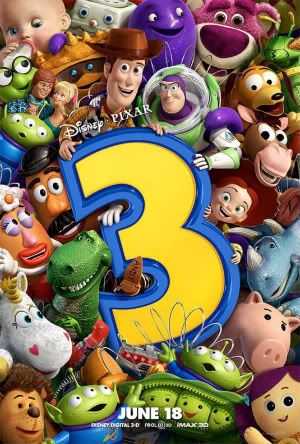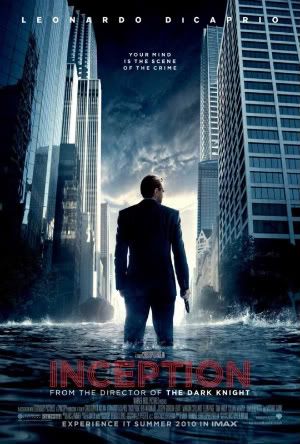

ROUND 1: PLOT
Toy Story 3 is the third in a trilogy, a hard department because the production staff must not only remain loyal to the first two in the series, but also be innovative and bring something new to the table. Inception is the first of what will likely be a series, with absolute freedom over plot because of this, and also because the plot takes place where anything is possible.
Toy Story 3 takes place approximately 10 years after the second film, in which Andy's last toys (Woody, Buzz Lightyear, Jessie, Bullseye, the Potatoheads, Rex, Hamm, the Pizza Planet aliens, Slinky Dog, and Barbie) find themselves donated to a daycare after their owner prepares to leave for college. Along the way, they encounter seemingly harmless toys with insidious intentions, incarceration, a child's room which gives Woody a glance into his past, and a horrific, heart-stopping trip to the city dump. Toy Story 3 is relentless in the best possible way - giving the audience genuine heroes to root for, who all the while wonder how the geniuses at Pixar can make a story about plastic junk so heartfelt. The creators of Toy Story knew they were tapping into good stuff - the bare bones love that a child shares with their toys, which most of us can relate to.
Inception, on the other hand, is a sci-fi thriller about Dominic Cobb, a dream stealer of sorts, in which he and his team (including the handsome Joseph Gordon-Levitt) infiltrate their subject's minds to either get information or implant ideas. Through special effects and the hackneyed usage of "a dream within a dream," the plot gets twisted and lost as entire scenes become irrelevant because they are not real. A thread that runs the course of the film is Cobb's troubled relationship with his wife and her violent death, and his urgency to get home to his children after being expatriated against his will.
ROUND 2: EFFECTS
Lets face it - lots of us go see movies these days to see things that we can't in real life. Special effects have a large role in this. In Toy Story, we are invited into the wild and colorful world of toys, which not only lassos us back into the wonder of being a child, but also makes us think twice about what we throw away. Although made to look more like a cartoon than real life, most of the animation replicates our world in a new and interesting way, and all of it feels authentic. Real expression appears on the faces of the characters, which makes us feel for them that much more. Even though he's a toy made to be played with by kids everywhere, Big Baby (a new character introduced for this film) still seems scary. Very quickly, one forgets they are watching a movie about things that don't actually move and speak, and are brought into the film despite the cartoonish animation.
Inception is hands down one of the most visually interesting films of the year. The key difference between Inception and Toy Story 3 in this regard is that it is live action, and the animation and special effects in some of the scenes are just breathtaking. Towards the end of the film, a fight sequence breaks out in the hallway of a hotel where gravity keeps shifting - probably the coolest fight sequence since the first Matrix film. There is also one scene where "architect" Ariadne (played by Ellen Page) folds a part of the city over in on its other, more physics-oriented half, which can be scene in many of the promotional photos and trailers for the film. Most of the film takes place in a beautiful dream world where anything is possible, however, most of the time the characters (nor the creative directors) allowed themselves to truly dream up ridiculous and amazing things, which was my number one gripe with the film.
ROUND 3: CHARACTER
The characters in a film can make or break a film. If you don't have a character one can relate to or care about, then the journey isn't as exciting or, in some cases, completely ineffective. Most people who saw Toy Story 3 have seen at least one of its predecessors, and, if you're like me, you saw them when you were a lot younger. In fact, I was Andy's age when the first film came out, so I could totally relate to his love for toys, and I could even relate to the toys themselves. A common theme between the three films was abandonment - more extensively explored in this film than the first two. Not only do the toys feel abandoned by their owner, but because Andy is leaving for college, we get to briefly glimpse into his mom's onset of empty nest syndrome. There is even a sad scene in the final moments of the film which takes Andy's breath away, indicative of the same feeling of loss that the rest of the toys deal with throughout the course of the movie.
Cobb's character in Inception is dealing with loss, as well - the loss of his wife, the loss of his family, and maybe even the loss of his sanity - which isn't clear cut by the end of the film. Most of the characters in the movie are one-dimentional, as well, given specific roles (the architect, the chemist, the forger) which leaves room for very little development. We do see the aforementioned Ariadne develop throughout the film - a character likely built into the script to provide the audience with explanations while learning alongside her. Even after we go into Cobb's mind, its as though the curtain is blatantly lifted off of his mystery rather than slowly unwrapping it like a good suspense film would do.
VERDICT: TOY STORY 3
So, I don't think its any surprise. I think that Toy Story 3 was far superior. In the words of my sister, "K.I.S.S. - Keep It Simple, Stupid." When you try to go into complex ideas like Inception, you have to go all the way - not just happily tie every knot in the end for the layman American audience. You have to be willing to throw your characters under the bus the way the writers of Toy Story 3 did (well, in their case, into the dump) and then justify why it matters. Because Inception takes place in a dream, it ultimately leaves the audience with the same feeling that Dorothy feels upon waking up at the end of "The Wizard of Oz" - disappointment.




No comments:
Post a Comment